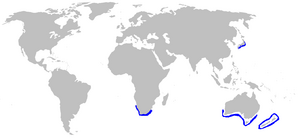Brown lanternshark facts for kids
Quick facts for kids Brown lanternshark |
|
|---|---|
| Conservation status | |
| Scientific classification | |
| Genus: |
Etmopterus
|
| Species: |
unicolor
|
 |
|
| Where the brown lanternshark lives | |
| Synonyms | |
|
Spinax unicolor Engelhardt, 1912 |
|
The brown lanternshark (Etmopterus unicolor) is a type of deep-sea dogfish shark. It's also sometimes called the bristled lanternshark. This shark is not very well known. It lives deep in the ocean, usually more than 300 meters (about 980 feet) down. You can find it near Japan and New Zealand. It might also live near South Africa and Australia.
This shark looks different from other lanternsharks because of its color. It's a plain dark gray or brown all over. Unlike other lanternsharks, its belly isn't much darker or sharply separated from the rest of its body. The brown lanternshark eats small bony fishes, cephalopods (like squid), and crustaceans (like shrimp). Female brown lanternsharks give birth to 9 to 18 young sharks. Interestingly, many brown lanternsharks in Suruga Bay have features of both male and female sharks.
Contents
What's in a Name? The Brown Lanternshark's Taxonomy
The brown lanternshark was first described in 1912 by Robert Engelhardt. He called it Spinax unicolor. Later, in 1965, another scientist named Tokiharu Abe moved it to the group of sharks we now call Etmopterus. Scientists believe that a shark known as the "bristled lanternshark" from Australia is actually the same species. The brown lanternshark is part of a group that includes other lanternsharks like the velvet belly lantern shark and the dwarf lanternshark. These sharks all have tiny, needle-shaped scales called dermal denticles that are not arranged in a neat pattern.
Where Do Brown Lanternsharks Live?
We know for sure that brown lanternsharks have been found off southern Honshu, Japan, and around New Zealand. If we include other similar sharks, then they might also live off South Africa and southern Australia. These sharks live on continental shelves and seamounts. They are found at depths from 402 to 1,380 meters (about 1,320 to 4,530 feet). They are most common below 900 meters (about 2,950 feet). Brown lanternsharks usually live deeper than other lanternsharks in the same areas. They might even spend time swimming in the middle of the ocean.
What Does a Brown Lanternshark Look Like?
The brown lanternshark has a strong, almost round body with a wide, flat head. It has about 28 rows of teeth in its upper jaw and 34 rows in its lower jaw. The teeth in the upper jaw have a sharp point in the middle with a few smaller points on the sides. The bottom teeth are large and have a strong, angled triangle shape. This shark has five pairs of fairly large gill slits.
It has two dorsal fins (fins on its back). The first dorsal fin is low and has a tiny spine in front of it. The second dorsal fin is twice as tall as the first and has a much bigger spine. The part of its body before the tail, called the caudal peduncle, is short. This leads to a long caudal fin (tail fin), where the top part is much bigger than the bottom part.
The shark's tiny scales, called dermal denticles, are packed closely together without a regular pattern. Each scale has a four-cornered base and a narrow, slightly curved point. On female sharks, these scales are firmly attached. On males, they can be removed easily. The shark is a plain dark gray or brown color. It's a little darker on its belly and lighter on the edges of its dorsal fins. Unlike other lanternsharks, there isn't a sharp change in color between its back and belly. It has a black line at the base of its tail and a fainter black mark above its pelvic fins. Males can grow up to 64 cm (about 25 inches) long, and females can reach 75 cm (about 30 inches).
How Do Brown Lanternsharks Live and Eat?
The main food for brown lanternsharks is bony fishes, especially lanternfishes. They also eat cephalopods, like the Watasenia scintillans squid, and prawns. A small creature called a copepod can sometimes be a parasite on this shark.
Like other lanternsharks, the brown lanternshark is ovoviviparous. This means the young sharks hatch from eggs inside the mother's uterus. They get their food from a yolk sac until they are born. A female shark gives birth to 9 to 18 young at a time. Newborn sharks are about 17 cm (about 6.7 inches) long. Males are ready to have young when they are about 46 cm (about 18 inches) long. Females are ready when they are about 50 cm (about 20 inches) long. A study in Suruga Bay found that about 23% of the brown lanternsharks there had features of both male and female sharks. Scientists are not sure why this happens, but some think it might be related to pollution.
Brown Lanternsharks and People
Brown lanternsharks are sometimes caught by accident when people are fishing, but they are usually thrown back into the ocean. They are harmless to humans and not important for fishing industries. The International Union for the Conservation of Nature (IUCN) has not fully studied their conservation status. They are listed as "Data Deficient," which means we don't have enough information to know if they are at risk. In 2018, New Zealand's Department of Conservation said the brown lanternshark is "Not Threatened" in their waters, and that it is "Secure Overseas."
See also
 In Spanish: Etmopterus unicolor para niños
In Spanish: Etmopterus unicolor para niños


